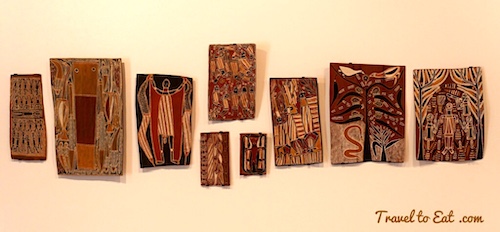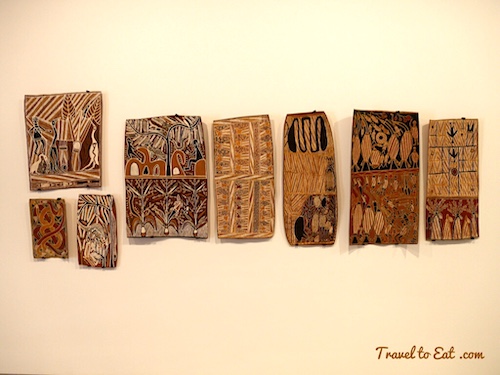
When Lisa and I visited the Museum of Contempory Art, they had an entire wall of beautiful bark paintings without (to me) comprehensible labeling p, with my apologies to the artists I have decided to present them here. Bark painting is an Australian Aboriginal art form, involving painting on the interior of a strip of Eucalyptus bark. This is a continuing form of artistic expression in Arnhem Land and other regions in the Top End of Australia including parts of the Kimberley region of Western Australia. Traditionally, bark paintings were produced for instructional and ceremonial purposes and were transient objects. Today, they are keenly sought after by collectors and public arts institutions. Bark paintings are based on sacred designs that include abstract patterns and designs (such as cross-hatching in particular colours) that identify a clan, and also often contain elements of the Eternal Dreamtime. Sometimes the elements of a story are obvious—such as men or animals—but sometimes the elements are symbolic. Many of the myths seem only to be concerned with a particular animal or bird. However in symbolic meaning of great importance. For instance, the Sun is a woman, she creates life and she is often symbolized by water, fire, earth and red ochre, the Moon is male and controls the tides and seasonal cycles – he is often symbolized by snake, dog, frog and also water.

This first group shows a coiled snake which reminds me of the ancient Egyptian game and God Mehen. Mehen was the giant serpent God who enveloped the sun God Ra during his nightly journey through Tuat. Serpents and snakes play a role in many of the world’s myths and legends including the Garden of Eden. Sometimes these mythic beasts appear as ordinary snakes. At other times, they take on magical or monstrous forms. Serpents and snakes have long been associated with good as well as with evil, representing both life and death, creation and destruction. In Australia Goriallia the Rainbow Snake is a God/force of nature from far off in Dreamtime (creation) when the land was featureless and gray. He awoke and set off looking for his tribe. The movement of his huge multicolored body across the land formed the mountains and the rivers that flow to the ocean. By lifting his tail he makes rainbows. The concept of the Rainbow Snake as a water spirit is found in many forms. Sometimes it is simply a guardian of a sacred pool or lake and will attack and bring ill health and bad fortune if the sacred place is not correctly respected. Aboriginals believe that each tribe is descended from the Beings of the Dreamtime. I love the end of the story:
You may never see these lakes or mountains, but after the rain you will see his spirit in the sky, which is the rainbow. This is the reason why he is called Goorialla the Rainbow Serpent.




A goanna is any of several Australian monitor lizards of the genus Varanus, as well as to certain species from Southeast Asia. Around 30 species of goanna are known, 25 of which are found in Australia. This varied group of carnivorous reptiles range greatly in size and fill several ecological niches. In 1994, excavations at Cuddie Springs in north central New South Wales exposed numerous bones of what is now known as Megalania, the giant Goanna. It was a true monster, its maximum length was approximately 5.5 meters, its weight about 600 kilograms, so it was twice the length of the Komodo Dragon and became extinct about 18,000 years ago. Goanna had a prominent place in the culture of Indigenous Australian Bundjalung Nation tribal groups. This included totemic relationships, anthropomorphic representations in Dreamtime stories, and as a food source. The Dirawong (Goanna) is known as a benevolent protector of its people (in the Bundjalung Nation) from the Rainbow Snake (also known as the ‘Snake’ or ‘Rainbow Serpent’). The Dirawong (Goanna) is also associated with rain and there is a rain cave on Goanna Headland where the Elders of the Bundjalung Nation people went in the old days to conduct ceremonies for rain.

“Nyangbal” tribes people believe that they are direct descendants in spirit of “mythical supernatural being architects”, the Rainbow Snake and Dirawong who created the land and the two totems; the Snake & the Goanna and the land in which Bundjalung Nation tribal groups live. This belief is very important to Nyangbal people, and the goanna of today constantly reminds Nyangbal people of that spiritual ancestor. These symbols are also important because they help to show man’s unity with nature. They feel special affinity with their related totem animal species.


In the Dreamtime all the birds were black – all one colour. Untill one day this little dove was flying around looking for food. He flew down to the ground to catch a big juicy grub but instead landed right on a sharp stick. It pierced his little foot and made him very sick. For days he lay on the ground in pain. His foot swelled up. He was dying. All his mates gathered around to see how they could help. All except the crow. He just wandered around with his hands behind his back. Suddenly the parrot rushed forward – and with her sharp beak BURST the little dove’s swollen foot. Colour splashed out all over the parrot. Red and green and blue ran down her chest, wings and tail. It splashed out all over the other birds. Some got red, some brown, some blue, some yellow. Some got spots. All got colours.

Piggi-Billa was getting old and not able to do much hunting for himself. Nor did he care too much for the flesh of Emu and Kangaroo as he did for the flesh of men. He used to entice young men to his camp by various devices and then kill them and eat them. At last the Daens found out what he was doing and were determined to punish him. We will cripple him they said, so that he shall be powerless against people. A mob of them went and surrounded his camp. He was lying asleep, face downwards, as he did not wish his Doowl or dream spirit to leave, as it might of done if he had slept on his back, with his mouth open. In his sleep he seemed to hear a rustling in the leaves, but suspected no evil, saying drowsily to himself, “It is the Bulla Bulla or the butterflies flittering around. Then he slept on while his enemies closed in around him. Raising their spears, with one accord, they threw them at him, until his back was one mass, with the spears sticking up all over it. Then the Daens rushed in and broke his arms and legs, with their boondis and waggaras or wooden axes, crippling him indeed. As he made neither sound or movement, they thought that they had killed him, and went back, satisfied with their vengeance, to the camp, meaning to return for their weapons later. As soon as the Daens were gone, Piggi-Billa crawled away on all fours to the under ground home of his friend, Murga Muggai, the spider. Down he went through the trap door and there he stayed until his wounds were healed. He tried to draw out the spears but was unable to do so, they stayed in his back forever. He went on all fours as his tribe have done ever since.


Before there were animals there was only people. There was a man named Budgial, a man named Gunual, and they were both in love with a girl named Gugu. The turtle man, Budgial, his totem represented common sense and love. Because he loved Gugu, he brought her flowers and sweet fruits; he watched the sun go down with her, he listened to her talk and he held her. One day the girl was getting teased by a bunch of people. So she asked the Turtle man to go and frighten them. When the turtle went to fight, he befriended them. She wasn’t happy with the outcome so she went to see Goanna man. The Goanna man’s totem is strength, power and greed. When she told the goanna man what had happened he went down to the river and he bashed them. Then he came back and told her what he did so she went home with him. Every day he brought her a big amount of food to show her how strong he was and what a great hunter he was.But he would never show her love because he felt that it was very weak, so she didn’t like that about him. He gave her a spear, when she threw it she missed and he was very angry. He chased after the spear and she ran down to the river to find the turtle man. When she found the turtle man she told him that goanna man was going to hit her, so he cuddled her and told her that everything would be ok. The goanna man followed her footprints and found the turtle man holding his woman, so he said to the turtle man, “I’m going to kill you that is my woman.” The turtle man held up two shields and then jumped into the water. When he was in the river the goanna man threw spears at him but the shields stopped the spears from killing him. Then he changed himself into a turtle. This is how the turtles became. The goanna man had seen him change from a man into a turtle and though he was the devil. So he ran back to the desert believing that all devils live in water. Till this day that is why the goanna lives in the desert and is very strong and powerful. The turtle lives in the water and if you ever se one they will swim away or go into their shell. And the girl who is the fish Gugu also lives in the water with the turtle.
I may not have matched the paintings properly with the stories but at least you got to see the paintings and hear some dreamtime or creation stories, although there are many details I left out due to a lack of space. I hope you enjoyed them.
References:
Serpents and Snakes: http://www.mythencyclopedia.com/Sa-Sp/Serpents-and-Snakes.html
Rainbow Serpent: http://www.didjshop.com/stories/rainbow.html
Dirawong: http://en.m.wikipedia.org/wiki/Dirawong
Megania: http://www.firstlighttravel.com/blog/aboriginal-mythology-some-truths-revealed/
Birds: http://www.billiluna.org.au/school-heritage-collection/86-how-the-birds-got-their-colours.html
Porcupines: http://www.didjshop.com/stories/piggi.html

